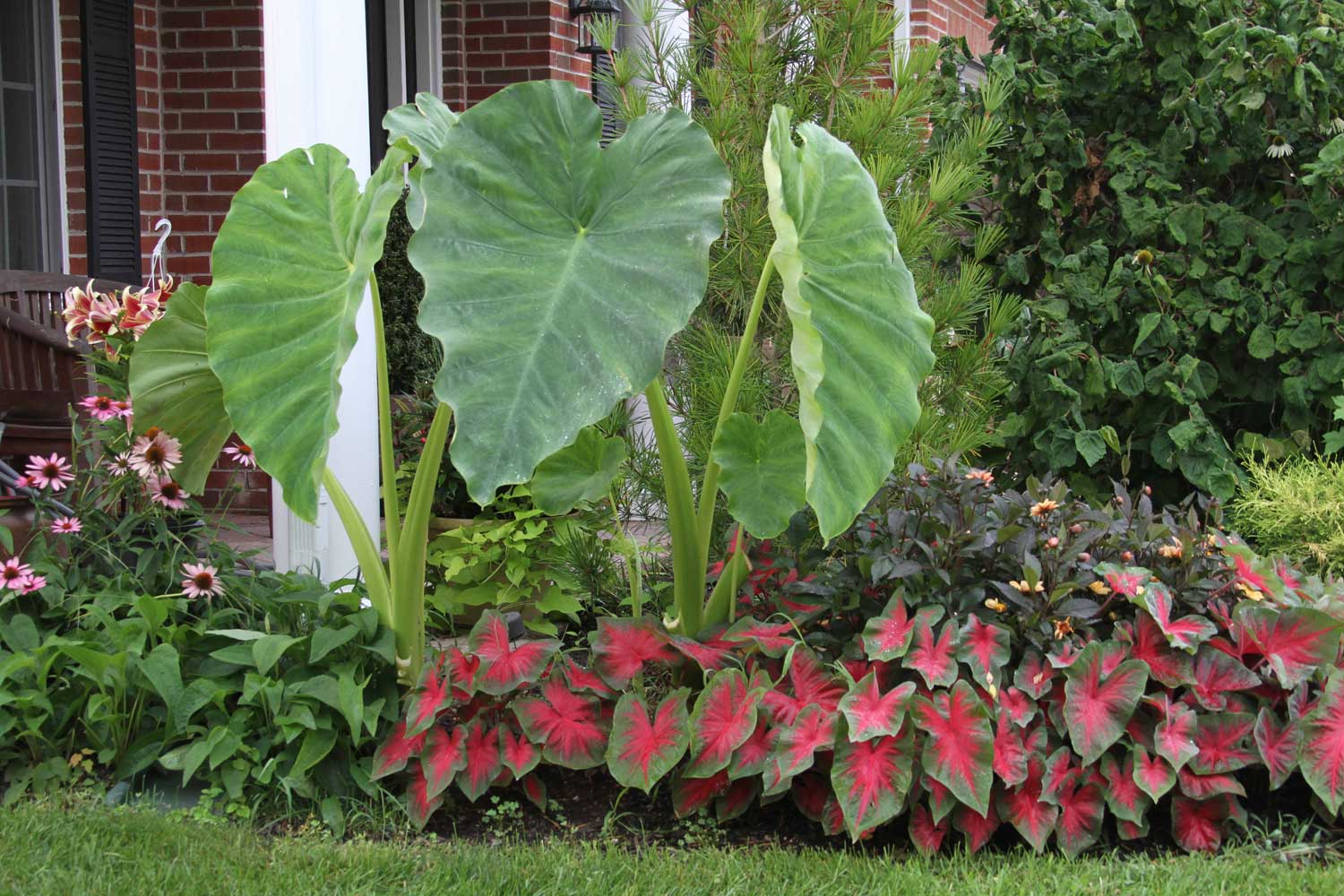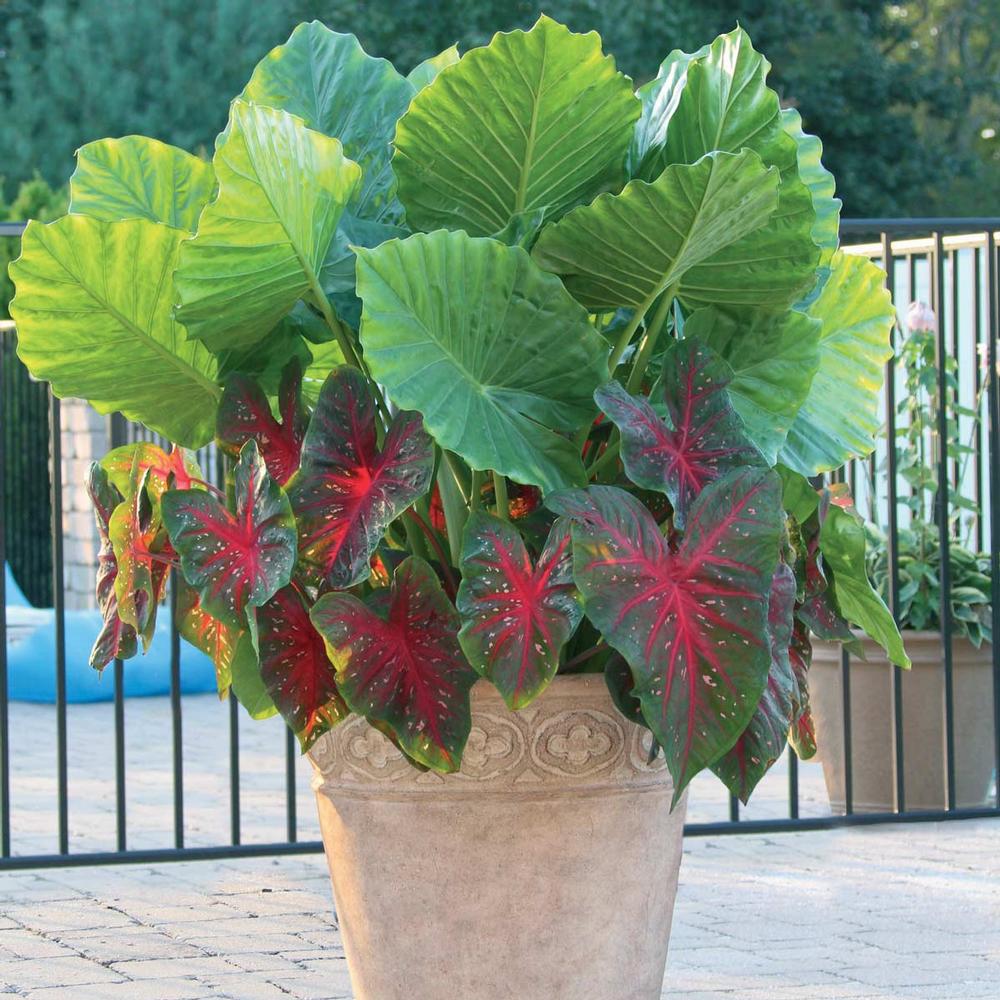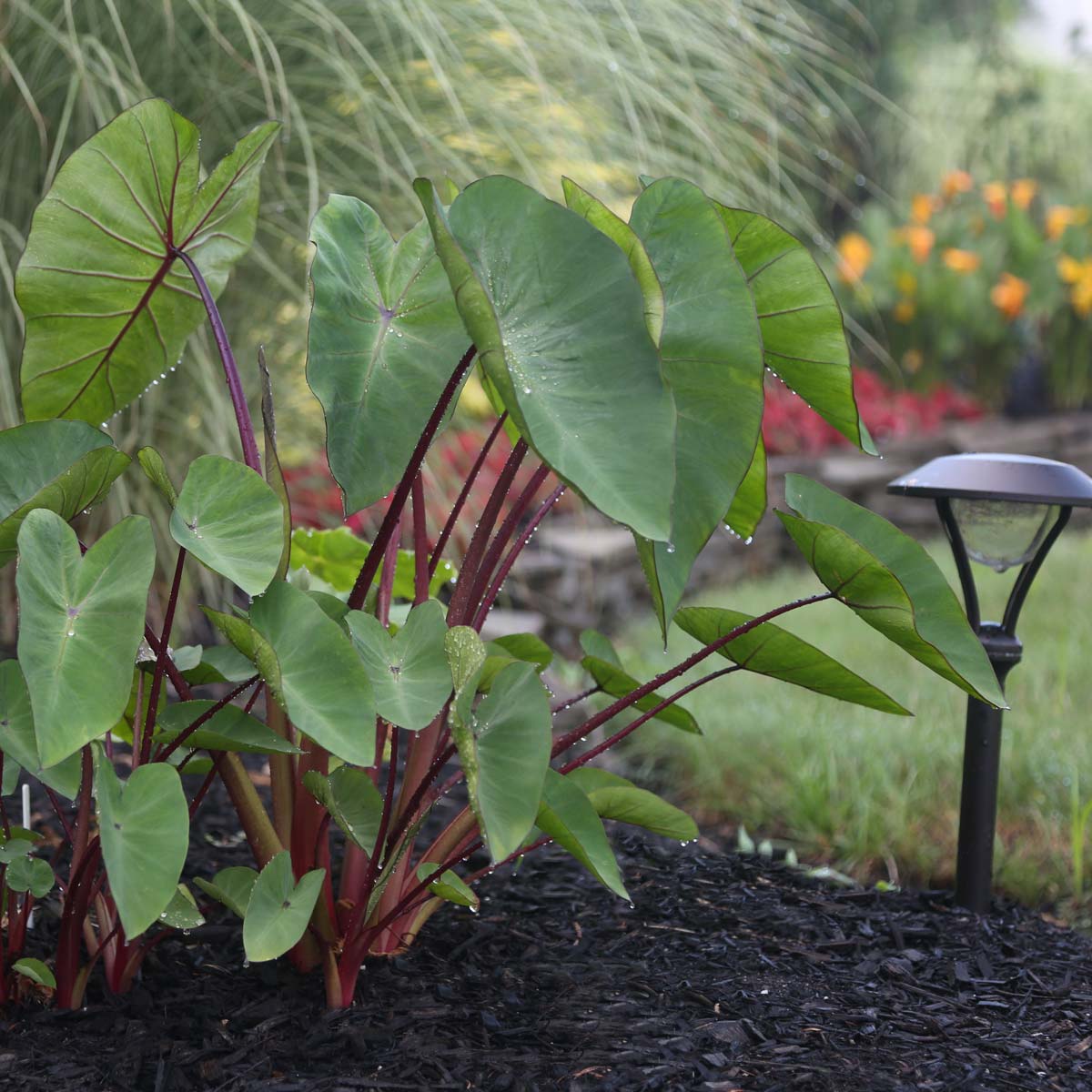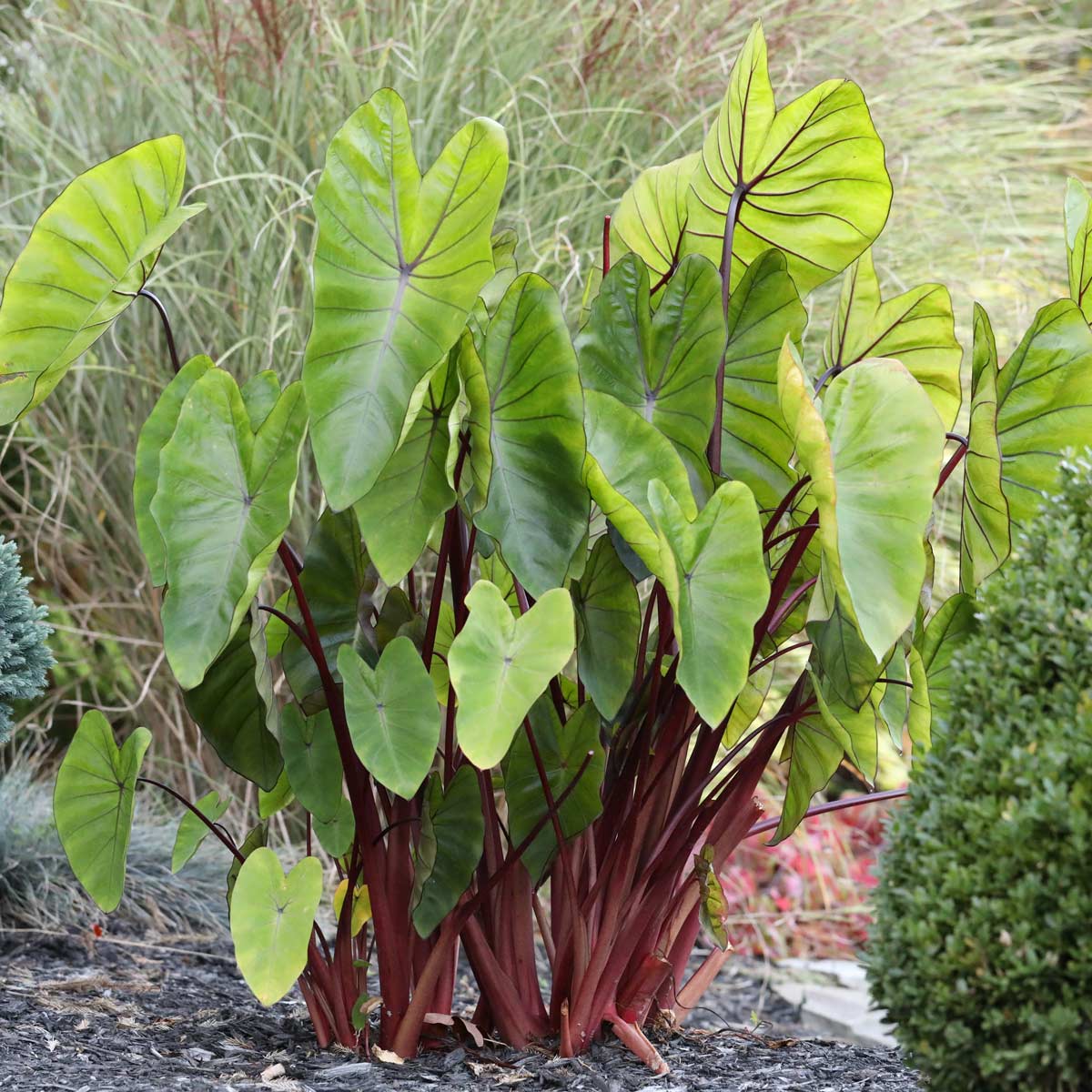Shake Up Your Garden With Elephant Ears

Want to add some excitement and personality to your garden this summer? Plant elephant ears! These tropical plants can grow up to 6 feet tall, with leaves as long as your arm. Elephant ears have always been popular in Florida and other parts of the deep south where they thrive in the summer heat and humidity. These days, they are being grown in nearly every part of the country – even in northern states.
Read on, if you’d like to learn more about these impressive tropical foliage plants, how to care for them, and creative ways to incorporate elephant ears into your garden and landscape.

Colocasia esculenta
Alocasia vs Colocasia
The common name “elephant ears” applies to two different species of plants.
Alocasias have glossy leaves that may be solid green, variegated, or display contrasting veining. Though there are some exceptions, you can usually recognize alocasias by the way they display their heart-shaped leaves. The tip of the heart either points outward, perpendicular to the stem, or straight up.
Alocasias are generally smaller in size than colocasias. This makes them popular for small gardens and containers. Alocasias are also sensitive to direct sunlight and prefer growing in partial shade. They should be planted in rich, well-drained soil. Too much moisture can stunt their growth.
Colocasias display their leaves with the tip of the heart pointing downward. These are moisture-loving plants and it’s almost impossible to overwater them. Most colocasias tolerate full sun. In fact, large ones such as Colocasia esculenta, require full sun to attain maximum size.

Alocisia ‘Odora’
What to Expect During the Winter
There is another other significant difference between alocasias and colocasias. In climates where elephant ears are hardy, most colocasias shed their leaves in the winter, while alocasias do not. You’ll want to keep this in mind when deciding where to plant your elephant ears and how to care for them over the winter.
In growing zones 9-11, alocasias can survive the winter outdoors and will retain their leaves all year round — as long as they are not damaged by cold weather. In areas where alocasias are not hardy (zones 4-8), you can either treat them as annuals or bring them indoors to grow as houseplants during the winter months.

Colocasias, on the other hand, die back to the ground in late fall. This happens even in climates where the bulbs are winter hardy. In zones 4-8, the bulbs should be overwintered indoors. Cut back the foliage in fall (before the first frost), dig up the bulbs, and store them in a dark, dry place at about 55°F. Replant in spring.
Remember that all elephant ears are sensitive to cold, and their foliage can be damaged if temperatures fall into the 30’s. If you live in zone 9, choose a planting location where a structure or other plants can provide some cold protection.

Colocasia ‘Black Stem’
Heat and Humidity
Most elephant ears are native to tropical regions: the Amazon Basin, Central Africa, and Southeast Asia. The air in these climates is hot and steamy, and soil temperatures rarely fall below 80°F. Though you may not be able to replicate these ideal growing conditions, knowing where the plants come from, should inform how you care for them.
Elephant ears grow best in a warm, sheltered location where they are protected from strong winds. In cool climates, you’ll find plants grow faster and get significantly larger when they are grown in containers. This is because the soil temperature in a container is always warmer than it would be in the ground.
Alocasias and colocasias detest cold soil. When soil temperatures are below 70°F, the bulbs will refuse to sprout and plants will not put on any growth. In the central U.S., elephant ears should not be planted outdoors until well after Memorial Day. In northern areas, soil temperatures are rarely warm enough until mid-June. If in doubt, it’s better to wait. Once the soil gets warm, the plants grow very quickly.

Colocasia ‘Hawaiian Punch’
Lots of Choices
As elephant ears become more popular, plant breeders are introducing lots of exciting new varieties. Leaf color, stem color, height and spread can vary widely, so pay close attention to the description. Some, like Colocasia esculenta Diamond Head have dark foliage. The leaves of colocasia Hawaiian Punch are smaller than average, but the plants form large clumps with lots of stems. Colocasia Black Stem has tall, maroon stems and a graceful, open growth habit. Colocasia Hawaiian Aloha has 18” wide leaves that are metallic teal blue. Hawaiian Maui Gold has chartreuse foliage on pale stems.
To learn more about growing and caring for these plants, read All About Elephant Ears. You can shop our selection of colocasia and alocasia bulbs for spring planting HERE.

HOW DO I GO ABOUT PURCHASING A CATALOG OF YOUR PRODUCTS? THANK YOU. CAROL
Hi Carol,
We do not have a catalog, but we do have a nice website where you can order our bulbs and plants: http://www.longfield-gardens.com
I love elephant ears, each and every specie. I really do. I would like to specialise in growing them on a commercial scale. I live in Zambia, Central Africa. Our winters are relatively mild…cold and dry then our summers a very hot and dry then we also have the hot and wet season. We do not have your typical Autumn, Summer Winter and Spring. I the city I live in we have several marshland areas that have residential housing. I believe the introduction of elephant ears would be beneficial to these areas. I would like to know where I can get a list of all known species complete with images and names.
Hi – all elephant ears are members of the aroid plant family. If you contact this organization, they may be able to help you. Good luck!
http://www.aroid.org/
[…] Source […]
My mother had some and they grew the most fragrant flower and it would last for weeks in beautiful Los Angeles I still have a couple of plants these were from the 50’s..
Dear Sir
I want to cultivate and grow the elephant ears for vegetable food.
So please let me know the leaves, stems and bulbs, corms etc. Of which elephant ear is edible .
Thank you
Regards
Mohammed Ali
Hi – We only grow elephant ears for ornamental purposes, so unfortunately I can’t answer your question.
I planted my first elephant plant this spring and they are now growing nicely.
Unfortunately, there is a leave that has turn brown and died. I have it in a large pot. Is that okay?
Hi Loretta – It’s normal for some of the old leaves to turn brown as new leaves open.
I’ve recently bought some small Elephant Ears with the intentions of planting them in my flower bed. But after just 3 hours sitting on the porch receiving the evening full sun 2 leaves were burnt. My backyard receives full sun in the morning and backyard receives full sun in the evening. What in the alocasia/colocasia family would withstand this amount of direct sun 4-6 hours a day? I’m in zone 8a-8b.
Hi – It’s possible that these plants were grown in a greenhouse and had never been exposed to direct sunlight. Many plants can adapt to handle more light if you expose them to it gradually — over a period of a week or so. You may find that alocasias and colocasias that have solid green leaves are more sun tolerant than the fancier types with variegated leaves or dark leaves. You could also ask at a local garden center. I don’t have experience growing in zone 8, so can’t make a good recommendation, sorry!
Hi
Where can i order bulbs for alocasia macrorrhiza variegata, colocasia mojito and Colocasias esculent ?
Please advise
Thanks
We carry colocasia esculenta (available in spring). You’ll find them HERE. We also have Alocasia macrorrhiza, but not the variegated one. HERE is the link for that one. We have offered Mojito in the past and may have it available again in spring 2021. Please check our website in January: longfield-gardens.com
I grew a huge elephant ear plant on my patio last summer and watered it every day. I brought it in for winter as I live in MD, trimmed some stalks, and started out only watering it once a week. The stalks started drooping and eventually turned yellow and died. I started watering it more recently and I think it’s doing better. Everything I read said to water less so i’m just not sure which is correct? Really don’t want to lose this beautiful plant.
Hi – you did the right thing bringing the plant indoors for the winter and not giving it much water. It’s normal for these plants to grow very slowly, if at all, during the winter. This is primarily due to the shorter day length and lack of light. Now that spring is here, repot the bulb in fresh soil and a larger pot (if needed). Give it as much light as you can while you are waiting for it to be warm enough to go outdoors. The limp stalks can be cut off. Stronger, thicker ones will come in once the weather is warm and the plant is getting more light. Once it’s in active growth, you can start fertilizing, too.
Hello. I live in Indonesia. My elephant ears are infested by some kind of insect. What can I do? They leave large perfectly round holes on the leaves.
Hi – Sorry, but I am unfamiliar with the insects in Indonesia. You’ll need to look closely and try to find one of the insects. Then you can ask locally for an ID and recommended solution.
Just purchased 2 large bulbs, coconut size and am unsure if should get in the ground now or wait until soil warms. Ice storm last week in Dallas area. The ones I planted last year from your company performed poorly on a shady hot patio. Keeping in cool dark area. May pot them this year?
Elephant ears will not tolerate frost and the bulbs will not start growing until the soil is warm. You can get them started indoors now, if you wish, and then move them outdoors next month when the weather is warm and settled. It usually takes the bulbs a couple weeks to wake up and start growing. If you can find a growing location where there’s at least half day sun or dappled sunlight, they will probably perform better. Once the plants are mature they can tolerate more shade.
Are any types of elephant ears suitable for an area shaded by tall trees (no midstory shade)?
Hi Lizzy – The most shade-tolerant elephant ears are alocasias — and they do vary. I don’t have any experience with this company, but they offer quite a few different varieties of alocasias and some are described as shade tolerant: Wellspring Gardens.
We live in Missouri and I’ve always been able to grow elephant ears. We’ve always cut the stalk’s down and dug up the bulbs and planted them again after the last spring frost. We moved and at the new home (built in the 1970’s, and the first year they did so-so. I bought new ears and these last two summers they haven’t even sprouted. What am I doing wrong?
Hi Denise – bulbs that arrive dormant can be VERY slow to sprout. Start them early in pots indoors and give them lots of warmth. I find plants that have been overwintered start growing again much more quickly and vigorously. You could also try purchasing some potted plants at a nursery next spring — rather than starting from the dormant bulbs. Consider the soil and planting location as well and try to mimic the growing conditions you had before.
Do you cut the leaves off when they turn brown as new leaves are opening
Hi – That’s what I do!